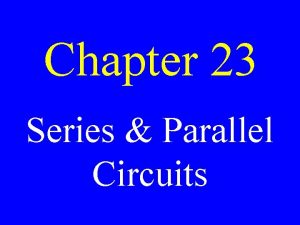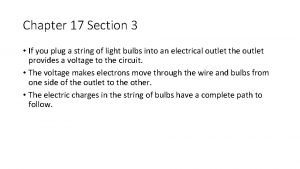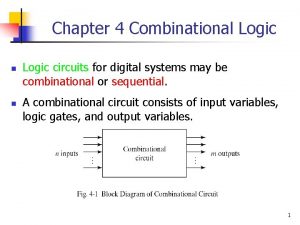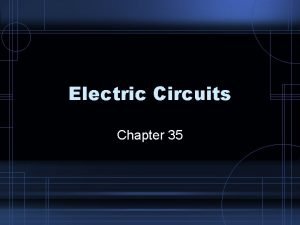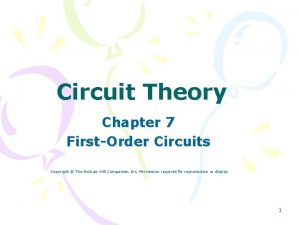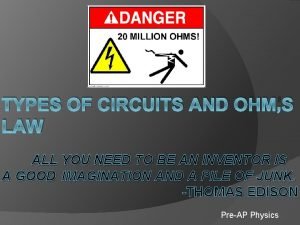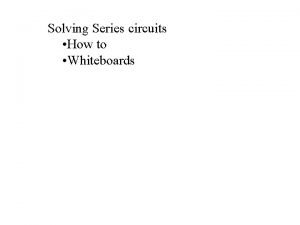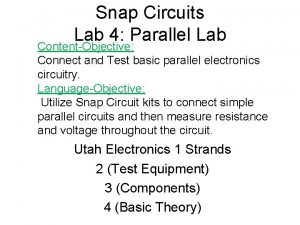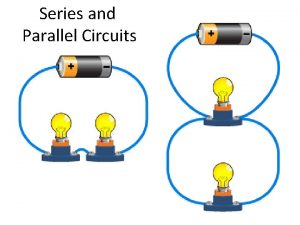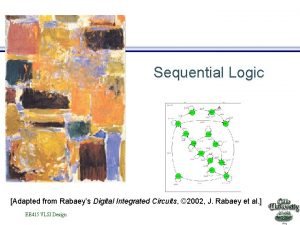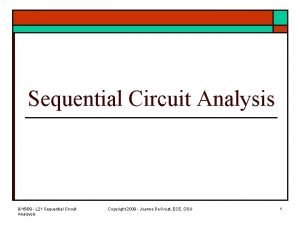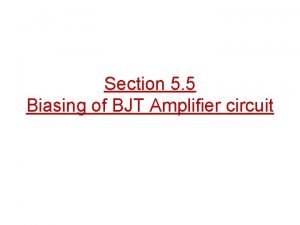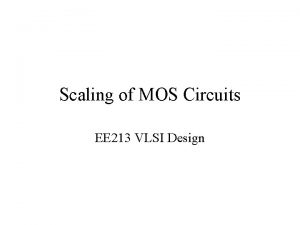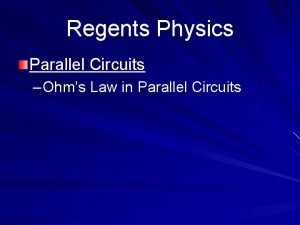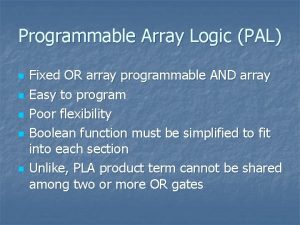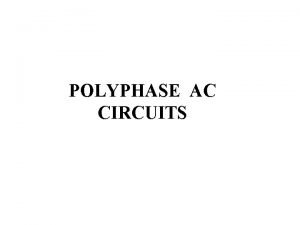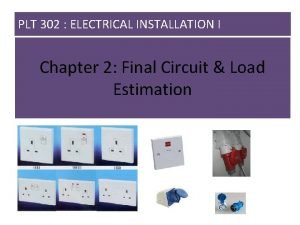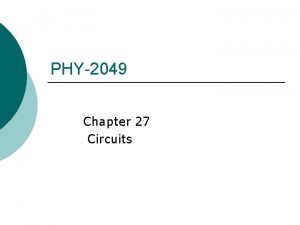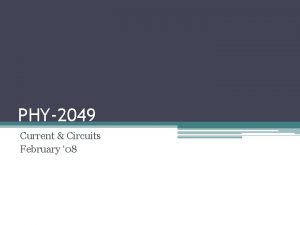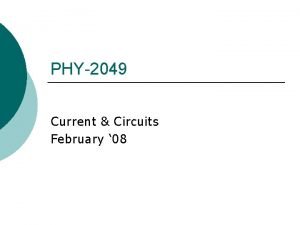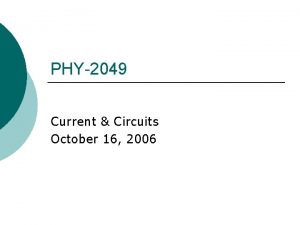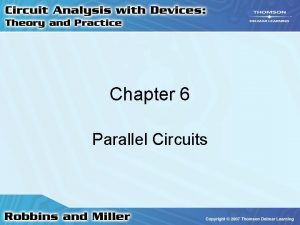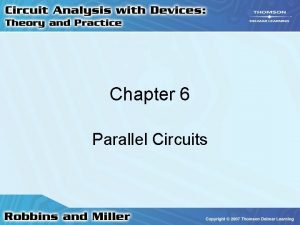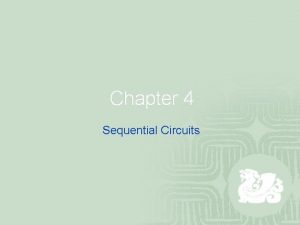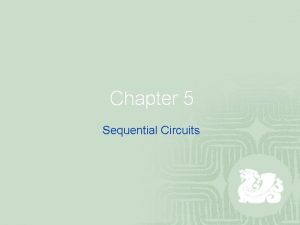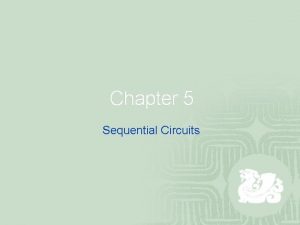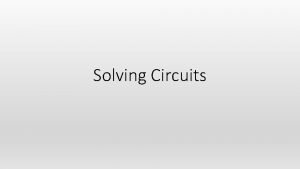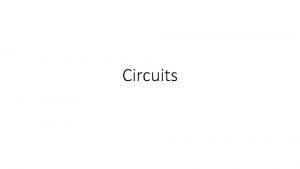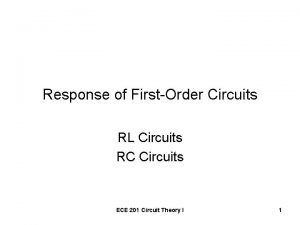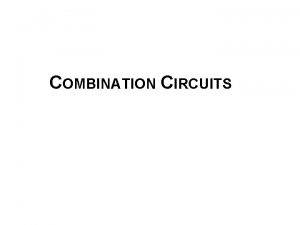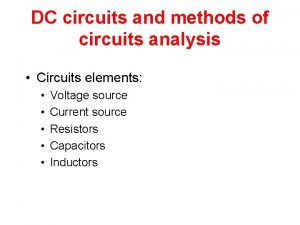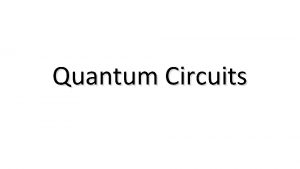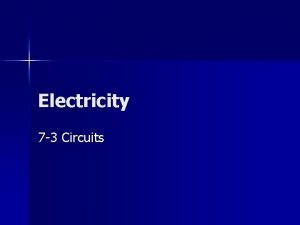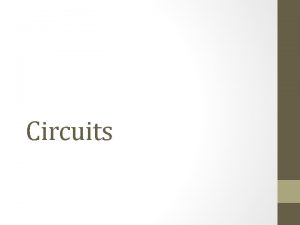PHY2049 Chapter 27 Circuits H ot H ot
































- Slides: 32

PHY-2049 Chapter 27 Circuits

H ot , H ot A closed circuit

Power in DC Circuit

#24 chapter 26: The figure below gives the electrical potential V(x) along a copper wire carrying a uniform current, from a point at higher potential (x=0 m) to a point at a lower potential (x=3 m). The wire has a radius of current in the wire? 2. 45 mm. What is the What does the graph tell us? ? *The length of the wire is 3 meters. *The potential difference across the wire is 12 m volts. *The wire is uniform. Let’s get rid of the mm radius and convert it to area in square meters: A=pr 2 = 3. 14159 x 2. 452 x 10 -6 m 2 or A=1. 9 x 10 -5 m 2 copper 12 volts 0 volts Material is Copper so resistivity is (from table) = 1. 69 x 10 -8 ohm meters

We have all what we need….

Let’s add resistors …….

SERIES Resistors i i Series Combinations R 1 R 2 V 1 V 2 V

The rod in the figure is made of two materials. The figure is not drawn to scale. Each conductor has a square cross section 3. 00 mm on a side. The first material has a resistivity of 4. 00 × 10– 3 Ω · m and is 25. 0 cm long, while the second material has a resistivity of 6. 00 × 10– 3 Ω · m and is 40. 0 cm long. What is the resistance between the ends of the rod?

Parallel Combination? ? R 1, I 1 R 2, I 2 V

#26 chapter 27: In Figure What’s This? ? ? below, find the equivalent resistance between points (a) F and H and [2. 5] (b) F and G. [3. 13]

Power Source in a Circuit The ideal battery does work on charges moving them (inside) from a lower potential to one that is V higher.

A REAL Power Source is NOT an ideal battery Internal Resistance V ε or Emf is an idealized device that does an amount of work to move a unit charge from one side to another. By the way …. this is called a circuit!

A Physical (Real) Battery Intern al Re sistan ce

Back to which is brighter?


Back to Potential Change in potential as one circuits this complete circuit is ZERO! Represents a charge in space

Consider a “circuit”. This trip around the circuit is the same as a path through space. THE CHANGE IN POTENTIAL FROM “a” AROUND THE CIRCUIT AND BACK TO “a” is ZERO!!

To remember ¡ In a real circuit, we can neglect the resistance of the wires compared to the resistors. l ¡ ¡ We can therefore consider a wire in a circuit to be an equipotential – the change in potential over its length is slight compared to that in a resistor A resistor allows current to flow from a high potential to a lower potential. The energy needed to do this is supplied by the battery.

¡ LOOP EQUATION l l ¡ The sum of the voltage drops (or rises) as one completely travels through a circuit loop is zero. Sometimes known as Kirchoff’s loop equation. NODE EQUATION l The sum of the currents entering (or leaving) a node in a circuit is ZERO

Take a trip around this circuit. Consider voltage DROPS: ε-ir -i. R = 0 or ε=ir + i. R

Circuit Reduction i=ε/Req

Multiple Batteries

Reduction Computes i

Another Reduction Example PARALLEL

START by assuming a DIRECTION for each Current Let’s write the equations.


RC Circuit ¡ ¡ ¡ Initially, no current through the circuit Close switch at (a) and current begins to flow until the capacitor is fully charged. If capacitor is charged and switch is switched to (b) discharge will follow.

Really Close the Switch

This is a differential equation. To solve we need what is called a particular solution as well as a general solution. ¡ We often do this by creative “guessing” and then matching the guess to reality. ¡

Result q=Cε(1 -e-t/RC)

q=Cε(1 -e-t/RC) and i=(Cε/RC) e-t/RC

Discharging a Capacitor qinitial=Cε BIG SURPRISE! (Q=CV) i i. R+q/C=0
 Series parallel circuit current
Series parallel circuit current Fundamentals of electric circuits chapter 4 solutions
Fundamentals of electric circuits chapter 4 solutions Electric current
Electric current Conceptual physics chapter 35 electric circuits
Conceptual physics chapter 35 electric circuits Chapter 23 series and parallel circuits answers
Chapter 23 series and parallel circuits answers Chapter 20 electric circuits
Chapter 20 electric circuits Chapter 17 section 3 circuits answer key
Chapter 17 section 3 circuits answer key The circuit chapter 9
The circuit chapter 9 Fundamentals of electric circuits chapter 7 solutions
Fundamentals of electric circuits chapter 7 solutions Chapter 35 electric circuits answers
Chapter 35 electric circuits answers Circuits ohm's law worksheet answers
Circuits ohm's law worksheet answers Quadruple 2 to 1 line multiplexer truth table
Quadruple 2 to 1 line multiplexer truth table Chapter 35 electric circuits
Chapter 35 electric circuits First order circuit
First order circuit Lesson outline lesson 3 describing circuits answers
Lesson outline lesson 3 describing circuits answers Virtual circuit and datagram network
Virtual circuit and datagram network Types of circuits and ohm's law ch 7.1 answers
Types of circuits and ohm's law ch 7.1 answers Spinal cord
Spinal cord Isolated instrumentation amplifier
Isolated instrumentation amplifier Solving series circuits
Solving series circuits Snap circuits project lab
Snap circuits project lab V
V Facts about series and parallel circuits
Facts about series and parallel circuits Non bistable sequential circuits
Non bistable sequential circuits Analysis of sequential circuits
Analysis of sequential circuits Bjt amplifier circuit
Bjt amplifier circuit Scaling of mos circuits in vlsi
Scaling of mos circuits in vlsi Ohm's law worksheet regents physics
Ohm's law worksheet regents physics Programmable array logic (pal)
Programmable array logic (pal) What is an incomplete circuit
What is an incomplete circuit Polyphase circuits
Polyphase circuits Radial circuits
Radial circuits Rangkaian logika sekuensial
Rangkaian logika sekuensial




